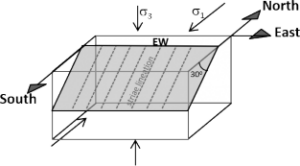Solution Exercise 8
a) The fracture shown in the photograph of Exercise 7a is depicted in the block diagram below. The very presence of the striae lineation on the face indicates propagation through shear. The dip of 60o and striae lineation parallel to the dip of the fracture are consistent with normal faults, which are generated in the extensional tectonic regime; this implies that σ1 is vertical. In this regime, σ3 is perpendicular to the direction of the fault, or N50W, and σ2 is parallel to its direction.

b) The fracture shown in the photograph of Exercise 7b is depicted in the block diagram below. The subvertical dip (88o) and the striae lineation on the face, almost parallel to the direction of the fracture, are consistent with strike-slip faults (propagated by shear) generated in the strike-slip tectonic regime. Thus, both σ1 and σ3 are horizontal and σ2 is vertical. The direction of σ1 depends on the movement sense of the fault. The small steps, transversal to the striae, imply a dextral movement (Petit, 1987) and the block to the right of the fault could have moved toward the observer, as shown in the block diagram. Therefore σ1 is N70W and σ3 (perpendicular to σ1) is N20E. This is one possible interpretation and more field data would be necessary to confirm it.

c) The fracture shown in the photograph of Exercise 7c is depicted by the block diagram below along with its striae lineation. The fracture presents two typical characteristics of faults (propagation by shear) generated in the compressive regime: a dip of 30o and striae lineation parallel to the dip of the fracture. In the compressive tectonic regime, σ1 is horizontal and perpendicular to the direction of the fault. This means that the σ1 direction is NS, σ3 is vertical and σ2 is parallel to the direction of the fault (EW).

The exercise includes the statement “striae lineation is assumed to be formed at the same time as the fracture, i.e., the striae lineation was not formed by reactivation.” This premise is reasonable because in each of the three faults illustrated by the photographs in exercise 7 both the fracture dip and the orientation of the striae lineation were consistent with a specific tectonic regime. The lack of this type of consistency, for example horizontal striae on fractures dipping 30o or 60o, would indicate reactivation.
Click to return to where text linked to Exercise 8
